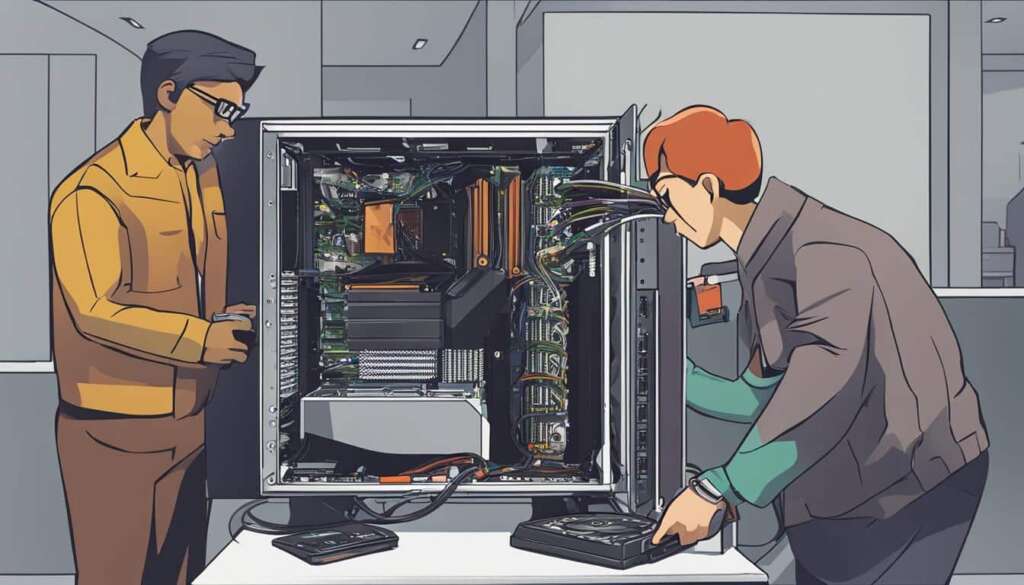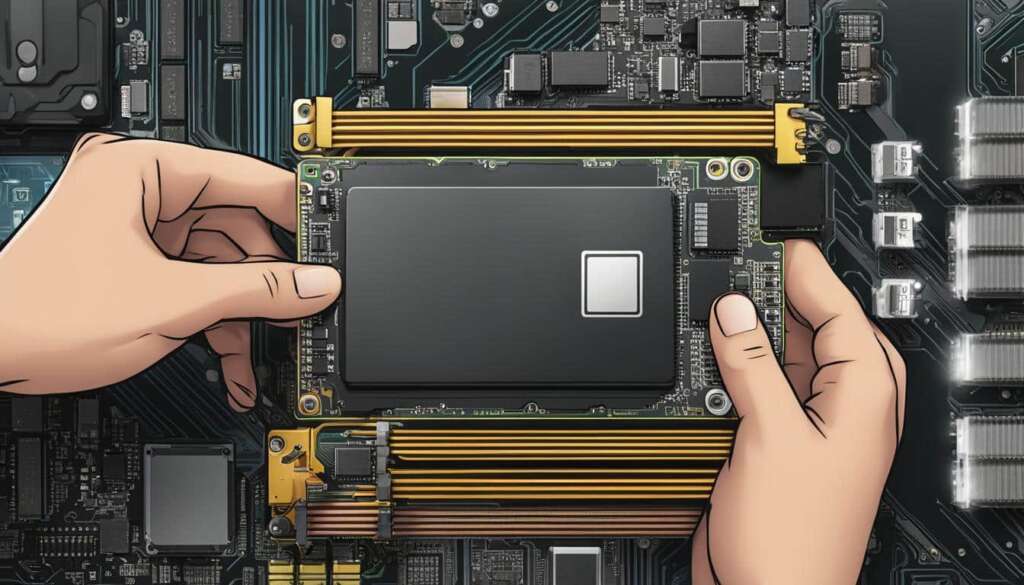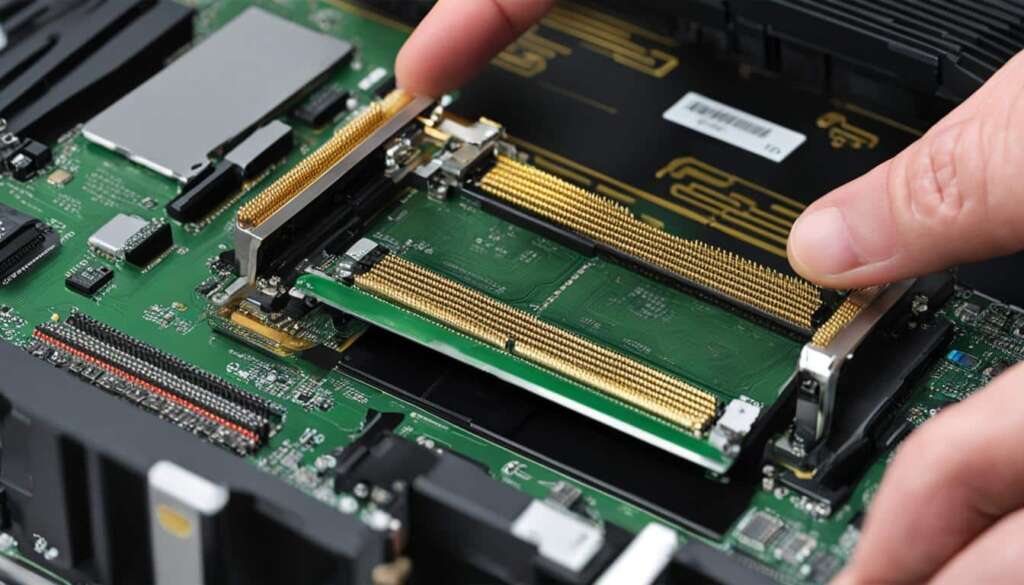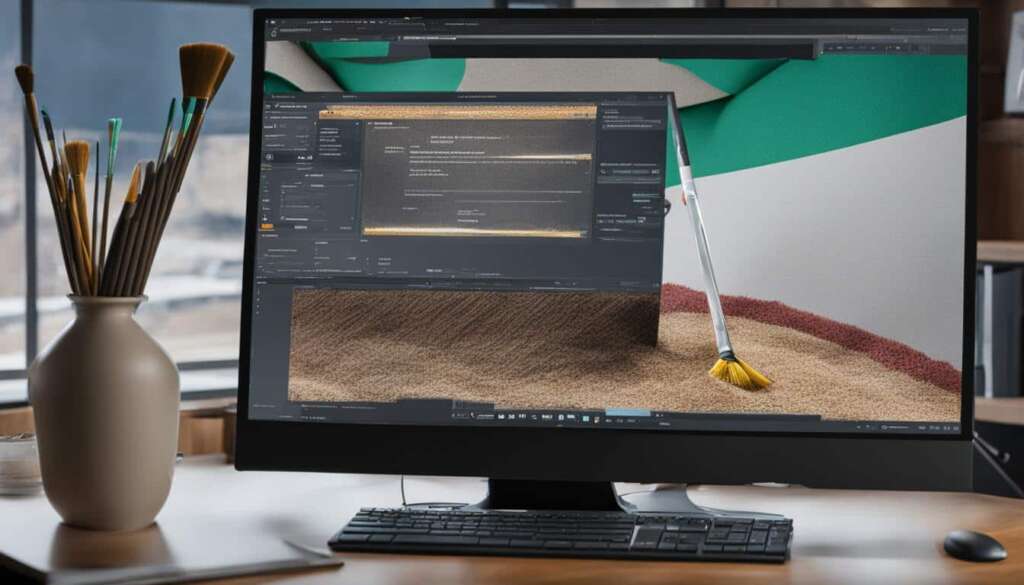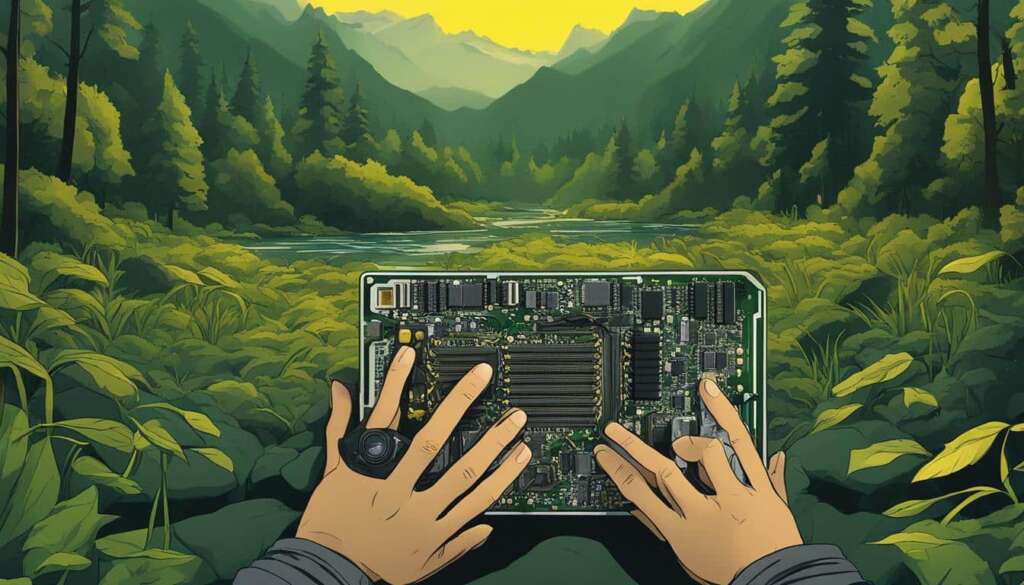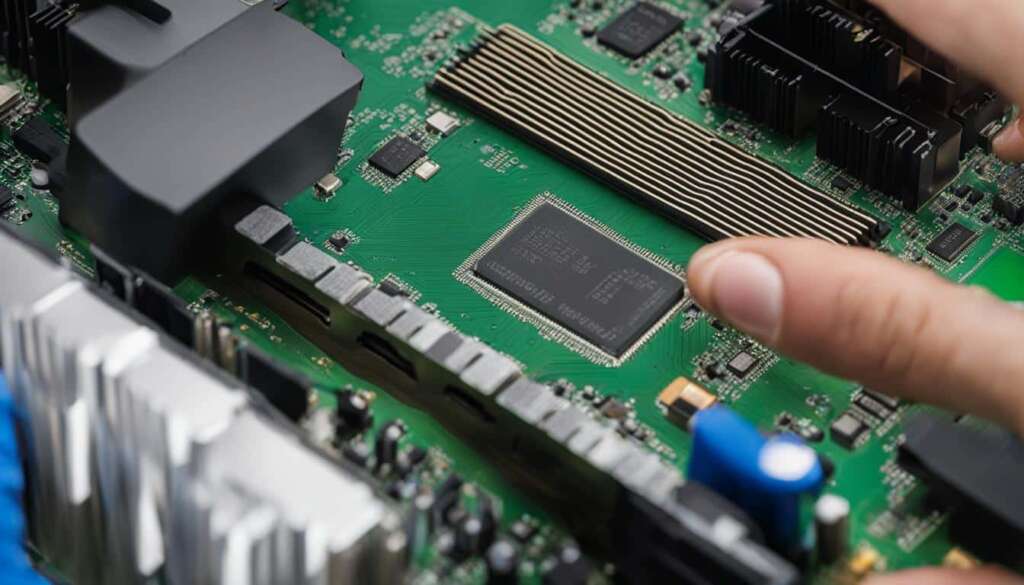Table of Contents
Are you looking to upgrade your PC’s performance and enhance its speed and storage? Installing an SSD in your desktop computer can make a significant difference. In this step-by-step guide, we will walk you through the process of installing an SSD, so you can enjoy faster boot times and improved program load times.
To begin, you will need the following supplies:
- A 2.5-inch SSD
- A screwdriver
- Your computer’s owner’s manual
Before proceeding, make sure to work in a static-safe environment and take precautions to protect your system’s components from static damage. Now, let’s get started:
- Shut down your system and open the desktop’s case.
- Ground yourself by touching an unpainted metal surface.
- Locate the storage bay where the SSD will be installed.
- If necessary, use a 2.5-inch to 3.5-inch converter to make the SSD fit snugly.
- Plug the SSD into your system, connecting the SATA cables to the motherboard and the power supply.
- Reassemble the desktop, power it on, and enjoy the improved performance of your PC with the newly installed SSD.
Installing an SSD in your PC is a simple process that can have a big impact on its performance. Follow this easy step-by-step guide, and you’ll be on your way to a faster and more efficient computer.
Choosing the Right SSD for Your PC
Before installing an SSD in your PC, it is important to choose the right one that fits your needs. There are two main types of SSDs: SATA and M.2. SATA SSDs are more affordable and offer a good balance of cost and performance. They are installed using SATA cables and are available in different storage sizes.
M.2 SSDs, on the other hand, are smaller in size and offer even faster read and write speeds. They are directly installed on the motherboard and are ideal for those looking for maximum performance.
When choosing an SSD, consider factors such as storage size, connection type, and read and write speeds. Determine how much storage space you need and whether your system supports SATA or M.2. Take into account the read and write speeds, as faster speeds can greatly improve performance.
“I was looking to upgrade my PC’s storage, and after considering the options, I decided to go with an M.2 SSD for its faster read and write speeds. With the increased performance, I can now enjoy quicker load times and a smoother overall computing experience.
Comparing SATA and M.2 SSDs
| Aspect | SATA SSD | M.2 SSD |
|---|---|---|
| Connection Type | SATA cables | Directly installed on motherboard |
| Storage Size | Available in different sizes | Smaller form factor |
| Read/Write Speed | Slower than M.2 | Faster than SATA |
By taking these factors into consideration, you can make an informed decision on the right SSD for your PC, ensuring optimal performance and storage capacity.
Cloning vs. Clean Install: Which Method to Choose
When installing an SSD in your PC, you have two options: cloning or clean install. Each method offers its own advantages and considerations, so it’s important to choose the one that best suits your needs. Let’s take a closer look at both options:
Cloning
Cloning involves transferring the data from your existing drive onto the new SSD. This method is a good choice if you want to replace your existing drive and keep all your data and programs intact. By cloning your existing drive, you can seamlessly transition to the new SSD without having to reinstall your operating system and programs.
Cloning is a relatively simple process and can be done using data migration software. This software creates a clone of your existing drive and transfers all the data, including the operating system, files, and applications, onto the new SSD. The result is a fully functional system on the new SSD.
One of the main advantages of cloning is that it saves you time and effort. You don’t have to reinstall your operating system or worry about transferring and reinstalling all your programs. It also allows you to keep your existing drive as a backup or for additional storage.
Clean Install
A clean install, on the other hand, involves formatting the new SSD and installing the operating system from scratch. This method is recommended if you want a fresh start and are willing to reinstall the operating system and all your programs.
By performing a clean install, you ensure that the new SSD is optimized for performance and free from any unnecessary files or software remnants. It allows you to start with a clean slate and eliminates any potential issues that may have existed on your previous drive.
While a clean install requires more effort and time compared to cloning, it offers the advantage of a clean and streamlined system. It allows you to carefully choose which programs and files to include, avoiding any unnecessary clutter or bloatware.
Considerations
When deciding between cloning and a clean install, it’s important to consider your needs and preferences. Here are a few factors to keep in mind:
- The condition of your existing drive: If your existing drive has issues or is nearing the end of its lifespan, a clean install may be the better option to avoid potential issues transferring data from a failing drive.
- Data migration: If you have a large amount of data or complex software setups, cloning can be more convenient and save you time.
- Desire for a fresh start: If you want to start fresh with a clean system without any unnecessary files or software remnants, a clean install is the way to go.
- Backups: Regardless of the method you choose, it’s important to have a backup of your important data. This ensures that you have a copy of your files in case anything goes wrong during the installation process.
Ultimately, the choice between cloning and a clean install depends on your specific needs and preferences. Both methods have their pros and cons, so take the time to weigh them against each other and choose the method that best aligns with your goals for the new SSD.
| Cloning | Clean Install |
|---|---|
| Transfers all data and programs from existing drive to new SSD | Formats the new SSD and installs the operating system from scratch |
| Fast and convenient | Offers a fresh start with optimized performance |
| Retains all data and programs | Eliminates unnecessary files and software remnants |
| Requires data migration software | Requires reinstalling the operating system and programs |
| Allows for a seamless transition | Requires more time and effort |
Benefits of Upgrading to an SSD
Upgrading to a solid state drive (SSD) offers significant advantages over traditional hard disk drives (HDDs). SSDs deliver faster and more responsive performance, resulting in shorter boot times and quicker loading of programs and applications. Unlike HDDs, SSDs have no moving parts, which reduces the risk of damage and enhances their overall lifespan.
Another notable benefit of SSDs is their lower power consumption and heat generation. By consuming less power, SSDs help improve energy efficiency and contribute to a greener computing environment. Additionally, the absence of mechanical components in SSDs makes them operate silently, providing a quieter and more enjoyable user experience.
When you upgrade to an SSD, you can expect a significant performance boost, smoother multitasking capabilities, and faster data transfer speeds. With an SSD’s superior reliability and durability, you can rely on your storage solution for longer periods without worrying about mechanical failures. Overall, upgrading to an SSD is a reliable investment that enhances both the performance and lifespan of your PC.
FAQ
How do I install an SSD in my PC?
Follow this step-by-step guide to install an SSD in your desktop PC and upgrade its performance and speed. Gather the necessary supplies, open the desktop’s case, locate the storage bay, plug the SSD into your system, and reassemble the desktop.
What types of SSDs are available and which one should I choose?
There are two main types of SSDs: SATA and M.2. SATA SSDs are more affordable and offer a good balance of cost and performance. M.2 SSDs are smaller in size and offer even faster read and write speeds. Consider factors such as storage size, connection type, and read and write speeds when choosing an SSD that fits your needs.
Should I clone or perform a clean install when installing an SSD?
The option to clone or perform a clean install depends on your preferences. Cloning transfers the data from your existing drive to the new SSD, keeping all your data and programs intact. A clean install formats the new drive and installs the operating system from scratch, providing a fresh start and optimized performance. Consider your needs and preferences when deciding which method to choose.
What are the benefits of upgrading to an SSD?
Upgrading to an SSD offers several benefits compared to traditional hard disk drives (HDDs). SSDs provide faster boot times and quicker program load times, have no moving parts which reduces the risk of damage and results in a longer lifespan, consume less power and generate less heat, and offer a quieter and more reliable storage solution. By upgrading to an SSD, you can greatly enhance the performance of your PC and enjoy a smoother and faster computing experience.

